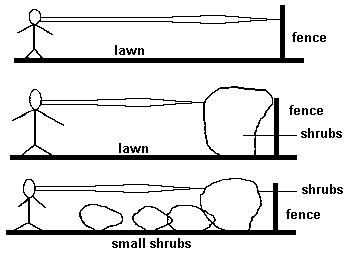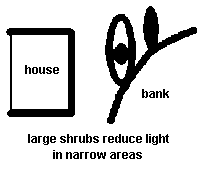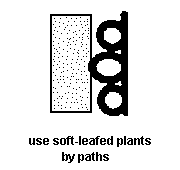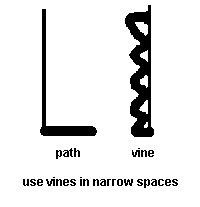|
[Front Page] [Features] [Departments] [SGAP Home Page] [Subscribe]

Garden Spaces and Styles
(How to Use Them to Achieve an Overall Design)
Leon Horsnell
Space can be defined as the distance between two objects. In a garden it is often related to our eye level, it can be simply the distance between ourselves and the back fence or the nearest screening shrub. Therefore space in our gardens is often the distance between fences and the house, between garden walls and houses, across the lawn etc. Our spaces in the garden will be defined by what we grow in them or to make them. The size, arrangement and what we use to define our spaces will set how our gardens will feel and look. We need to ask ourselves what spaces we need in the garden, eg. do we need room for the children to kick footballs or to throw basketballs! Do we need sitting areas, shrub areas, woodland, tall shrub, lawns etc?
Types of Garden Spaces
1. Practical Spaces
- Working areas; eg. areas for compost bins, rubbish
- Clothes lines
- Sitting and relaxing areas
- Car spaces
- Playing areas
2. Intimate Spaces
Smaller spaces where people can meet to talk, work, relax, have coffee etc. These spaces consist of paving protected by vegetation, often screening shrubs and trees. These areas need shade to give protection against the sun.
3. Wide Open Spaces
Where one can feel expansive. Screening vegetation is traditionally at a distance with a lawn in the middle. This results in an expansive feel to the garden. However, the same effect can be achieved without lawns by using appropriately sized shrubs. These open spaces sometimes are called vistas where the long views lead to a feature eg. pool, statue, or a special plant.
4. Combination of Intimate and Wide Open Spaces
We can combine these two effects in order to achieve intimate spaces with also a wide open feel on one side.
5. Overhead Spaces
Mostly created by using trees but also by pergolas etc. These are very important for shade but also to give a garden a three dimensional feel. They help to make a space more intimate by enclosing an area and can be combined into intimate spaces and also wide open spaces.
How Do You Achieve These Garden Spaces?
Traditionally these spaces are achieved by using a combination of paving lawn, shrubs and trees with screening around the edges. In native gardens we are attempting to achieve a bush effect which requires a different approach to the traditional garden. However in native gardens we also need the traditional spaces eg. sitting areas, intimate areas and those which give a feeling of expansiveness.
 
|
Various ways of designing the same space to retain a spacious "feel"
|
It is possible to achieve the same effect as those in traditional gardens and obtain a bushy feel with an expansive feel without using lawns (or by reducing lawns). This can be achieved by planting areas with small native shrubs and through the different spacing of shrubs. Thus if the lawn is replaced by small shrubs, grasses and herbs, we can keep the spacious feeling of a lawn but not require lawn (lets call this a woodland area). This way we retain the spacious feeling but gain a bushy feeling and not have much lawn to mow. Small areas of lawn can be used to expand the paved area so that people can flow from the paved area to the lawn. This lawn can be disguised by planting the edges with shrubs etc. A feeling of spaciousness can also be achieved by widely spacing larger shrubs thus leaving vistas between them (This is very much the case in the Australian National Botanic Gardens).
 
|
Combining spaces and elements to form the garden
|
Placement and Combination of Spaces
Placement of spaces
One should place and combine the spaces to give an attractive outdoor living space that draws one outside to relax in almost all weathers.
The placement of the various spaces or elements in a garden is determined by many considerations including solar ones and aesthetic ones. It is very important and one must look at the garden from many different angles before deciding on where things are placed. We can consider all the elements. One should aim not to have the tool shed or garage as the main view.
If possible, move sitting areas away from the house so that you have to go out into your garden to sit down. This also brings the garden closer to the house and improves the view from the house by replacing paving near the house with plants. It can also result in bringing birds up closer to the house.
Place woodland areas to give a maximum feeling of spaciousness; tall shrub areas to screen and give a feeling of intimacy. Trees should be placed to give protection from the sun and for aesthetic considerations.
Consider These Angles:
- From the garden - Have you screened everything that needs screening? Have you decided on the look that you want to achieve in the garden? Have you left the views and vistas unscreened?
- When in the kitchen - One can spend a lot of time in the kitchen so why not have a lovely scene or vista from the kitchen window? A bird bath can provide a focus and interest away from the dishes.
- When in the lounge room - One can have an expansive or wide open vista looking out onto the best features and most restful part of the garden.
- Other rooms - What views do you want to achieve from them?
- From the street - Step back over the street to decide what you want to achieve in the front and what suits your house.
Combination of Spaces
Combine paving, intimate and wide open as well as overhead to achieve the feel of intimacy and expansiveness that you want. The sitting areas should be sited to give shade in summer but sun in winter. The desired effect is achieved by planting the appropriately sized shrubs ie. to give screening and intimate effects, tall shrubs are planted whilst wide open spaces are achieved by planting small shrubs, herbs and grasses or lawn and overhead, by planting appropriate trees.
Gum trees should be planted also to give an Australian "feel".
Problem Spaces
Narrow Spaces



These are often the worst-handled spaces in gardens. The most important thing is the placement of paths and driveways so that the spaces beside them are not too narrow. The front path one metre from the house that slowly gets over crowded with bushes is very common. Also the driveway with bushes that scrape the car and leave little room is also common. These can be solved with good planning and proper selection of bushes or trees.


Trees can be used to good effect in some narrow spaces by the cutting of lower limbs and then allowing the canopy to cover the drive or path.
South-facing Backyards
In backyards with a southerly aspect (Southern hemisphere!), the problem occurs of obtaining enough shade in summer if paved areas are placed near the house. A solution is to place paved areas away from the house so that trees can be planted to provide shade, or to build a pergola.

[Front Page] [Features] [Departments] [SGAP Home Page] [Subscribe]
Australian Plants online - March 1998
The Society for Growing Australian Plants
|